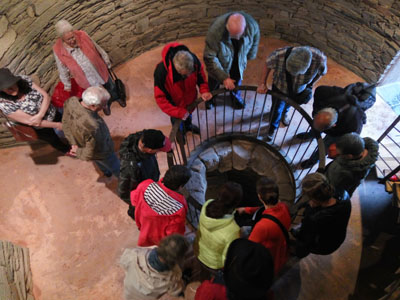Une
journée bien remplie
Même les fortes pluies dans l'après-midi
n'ont
pu entamer la bonne humeur des 14 adhérents qui ont
passé une journée
variée et intéressante dans la région
du Pays de Brive en Corrèze le 18 mai.
Le but principal de notre voyage était de visiter le
vigneron Coteaux de la
Vézère au Saillant, à
proximité de la ville médiévale
d'Allassac. C'est le
vignoble qui, depuis deux ans, a tenté d'obtenir l'
Appellation d'Origine Contrôlée
(AOC) délivrée par l'Institut national de
l'origine et de la qualité (INAO),
l'organisme qui contrôle et surveille la qualité
du vin français. Nous avons eu
la primeur de cette information :cette récompense ayant
été attribuée quelques
jours auparavant.
Depuis une dizaine d'années 13 vignerons
se sont regroupés pour reprendre une production
traditionnelle . Au 6ème
siècle, Arédius (ou St. Yrieix en devenir)
écrivit sur les vins exceptionnels
de cette région. Les vignes étaient en grande
partie la propriété de l'église
et ont généré beaucoup de revenus. En
1762, l'annuaire de l'église et du
journal de Limousin décrit les vins d'Allassac comme
«le meilleur vin de
Bas-Limousin, capiteux et chaud sur l'estomac». En 1840, la
Corrèze avait plus
de vignes que l'Alsace!
Mais en 1876, le phylloxéra a frappé la
Corrèze avec des résultats
dévastateurs
pour les grands cépages français et pour
l'économie! Les agriculteurs se sont
tournés vers d'autres cultures: fruits et légumes
- et l'élevage de bovins qui
pouvaient être facilement transportés en train
vers les grandes villes.
Les vignes étaient encore cultivées mais
principalement par des particuliers
pour la consommation domestique - une pratique qui continue. Mais
maintenant,
le petit groupe de cultivateurs enthousiastes et les entrepreneurs qui
ont
formé les Coteaux de la Vézère se
battent pour ramener la tradition des vins
fins avec une fraîcheur et une saveur particulière
dues à la spécificité du
terroir: schiste vertical. L'autre objectif est le passage en Bio en
moins de
10 ans: la reconversion est en cours-
Après une visite très documentée des
vignobles et du chai menée par René Maury,
président de la coopérative, il a
été possible de goûter et d'acheter la
gamme
de vins de la cave. Ici, il est devenu évident qu'une grande
partie du succès
de cette opération est à mettre à
l'actif de M.Puisais l' œnologue
depuis de nombreuses années de la cave Coteaux de la
Vézère.
Et donc déjeuner ...
Ensuite déjeuner au Cheval Blanc à Allassac,
où les jeunes propriétaires
proposent une cuisine « maison »
à partir de produits locaux. L'accueil fût
cordial, la nourriture excellente et
l'ambiance conviviale,
fortement recommandée à tous ceux qui visitent la
ville!
Et puis la pluie est tombée ...
Lorsque nous nous sommes approchés de la fin de notre
déjeuner, les pluies
annoncées sont arrivées . Nous nous sommes
réfugiés à l'office de
tourisme
en compagnie de l'adjoint au maire d'Allassac
et des guides de Pays d'art et d'histoire . Cependant, nous avons
beaucoup
appris sur l'histoire de la Tour Cèsar et son rôle
dans la défense de la ville
et profité de la vue panoramique depuis son toit de 30
mètres avant de
retourner au Saillant et à la petite chapelle.
Cette chapelle est l'une des quatre seules au monde dans laquelle tous
les
vitraux ont été conçus par le
célèbre artiste français Marc Chagall
du XXe
siècle. C'était son dernier travail avant sa mort
à l'âge de 98 ans et est le
seul en France.
Notre goûter prévu au bord de la
Vézère à l'ombre du pont
médiéval qui rejoint
Saillant-Allassac avec Saillant-Voutezac a dû être
« délocalisé »
à la cantine
ouvrière du vignoble en raison de la
météo .
Pour ceux qui s'intéressent davantage à Allassac
et à Chapelle à Saillant, nous
pouvons vous recommander le nouveau videoguidelimousin.fr disponible en
français et excellent anglais;







